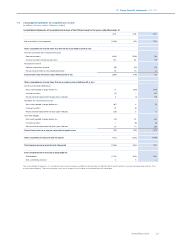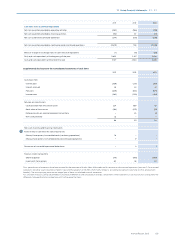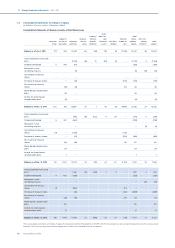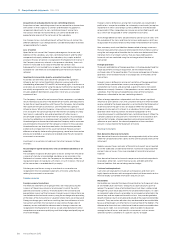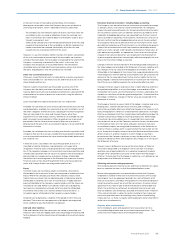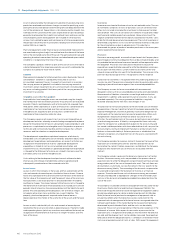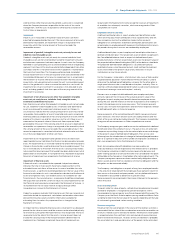Philips 2013 Annual Report Download - page 141
Download and view the complete annual report
Please find page 141 of the 2013 Philips annual report below. You can navigate through the pages in the report by either clicking on the pages listed below, or by using the keyword search tool below to find specific information within the annual report.
11 Group financial statements 11.9 - 11.9
Annual Report 2013 141
sold to entities other than private households, a provision is recognized
when the Company becomes responsible for the costs of this waste
management, with the costs recognized as Other business expenses or
Cost of sales as appropriate.
Impairment
Value in use is measured as the present value of future cash flows
expected to be generated by the asset. If the carrying amount of an asset is
deemed not recoverable, an impairment charge is recognized in the
amount by which the carrying amount of the asset exceeds the
recoverable amount.
Impairment of goodwill, intangible assets not yet ready for use and
indefinite-lived intangible assets
Goodwill, intangible assets not yet ready for use and indefinite-lived
intangible assets are not amortized but tested for impairment annually
and whenever impairment indicators require. In most cases the Company
identified its cash generating units as one level below that of an operating
segment. Cash flows at this level are substantially independent from other
cash flows and this is the lowest level at which goodwill is monitored by
the Executive Committee. The Company performed and completed
annual impairment tests in the same quarter of all years presented in the
Consolidated Statements of income. An impairment loss is recognized in
the Statement of income whenever and to the extent that the carrying
amount of a cash-generating unit exceeds the unit’s recoverable amount,
which is the greater of its value in use and fair value less cost to sell. An
impairment loss on an investment in associates is not allocated to any
asset, including goodwill, that forms part of the carrying amount of the
investment in associates.
Impairment of non-financial assets other than goodwill, intangible
assets not yet ready for use, indefinite-lived intangible assets,
inventories and deferred tax assets
Non-financial assets other than goodwill, intangible assets not yet ready
for use, indefinite-lived intangible assets, inventories and deferred tax
assets are reviewed for impairment whenever events or changes in
circumstances indicate that the carrying amount of an asset may not be
recoverable. Recoverability of assets to be held and used is recognized
and measured by a comparison of the carrying amount of an asset with the
greater of its value in use and fair value less cost to sell. Value in use is
measured as the present value of future cash flows expected to be
generated by the asset. If the carrying amount of an asset is deemed not
recoverable, an impairment charge is recognized in the amount by which
the carrying amount of the asset exceeds the recoverable amount. The
review for impairment is carried out at the level where discrete cash flows
occur that are independent of other cash flows.
Impairment losses recognized in prior periods are assessed at each
reporting date for any indications that the loss has decreased or no longer
exists. An impairment loss is reversed if and to the extent there has been a
change in the estimates used to determine the recoverable amount. The
loss is reversed only to the extent that the asset’s carrying amount does
not exceed the carrying amount that would have been determined, net of
depreciation or amortization, if no impairment loss had been recognized.
Reversals of impairment are recognized in the Statement of income.
Impairment of financial assets
A financial asset is considered to be impaired if objective evidence
indicates that one or more events have had a negative eect on the
estimated future cash flows of that asset. In case of available-for-sale
financial assets, a significant or prolonged decline in the fair value of the
financial assets below its cost is considered an indicator that the financial
assets are impaired. If any such evidence exists for available-for-sale
financial assets, the cumulative loss - measured as the dierence between
the acquisition cost and the current fair value, less any impairment loss on
that financial asset previously recognized in the Statement of income - is
reclassified from the fair value reserve in equity (through Other
comprehensive income) to the Statement of income.
If objective evidence indicates that financial assets that are carried at cost
need to be tested for impairment, calculations are based on information
derived from business plans and other information available for
estimating their fair value. Any impairment loss is charged to the
Statement of income.
An impairment loss related to financial assets is reversed if in a subsequent
period, the fair value increases and the increase can be related objectively
to an event occurring after the impairment loss was recognized. The loss is
reversed only to the extent that the asset’s carrying amount does not
exceed the carrying amount that would have been determined if no
impairment loss had been recognized. Reversals of impairment are
recognized in the Statement of income except for reversals of impairment
of available-for-sale equity securities, which are recognized in Other
comprehensive income.
Employee benefit accounting
A defined contribution plan is a post-employment benefit plan under
which an entity pays fixed contributions into a separate entity and will
have no legal or constructive obligation to pay further amounts.
Obligations for contributions to defined contribution pension plans are
recognized as an employee benefit expense in the Statement of income in
the periods during which services are rendered by employees.
A defined benefit plan is a post-employment benefit plan other than a
defined contribution plan. The net pension asset or liability recognized in
the Consolidated balance sheet in respect of defined benefit post-
employment plans is the fair value of plan assets less the present value of
the projected defined benefit obligation (DBO) at the balance sheet date.
The projected defined benefit obligation is calculated annually by
qualified actuaries using the projected unit credit method. Recognized
assets are limited to the present value of any reductions in future
contributions or any future refunds.
For the Company’s major plans, a full discount rate curve of high-quality
corporate bonds (based on Towers Watson RATE:Link data) is used to
determine the defined benefit obligation, whereas for the other plans a
single-point discount rate is used based on the plan’s maturity. Plans in
countries without a deep corporate bond market use a discount rate based
on the local sovereign curve and the plan’s maturity.
Pension costs in respect of defined benefit post-employment plans
primarily represent the increase of the actuarial present value of the
obligation for post-employment benefits based on employee service
during the year and the interest on the net recognized asset or liability in
respect of employee service in previous years. The Company presents
service costs in Income from operations and net interest expenses related
to defined benefit plans in Financial expense.
Remeasurements of the net defined benefit liability comprise actuarial
gains and losses, the return on plan assets (excluding interest) and the
eect of the asset ceiling (excluding interest). The Company immediately
recognizes all remeasurements in Other comprehensive income.
The Company recognizes gains and losses on the settlement of a defined
benefit plan when the settlement occurs. The gain or loss on settlement
comprises any resulting change in the fair value of plan assets and change
in the present value of defined benefit obligation. Past service costs
following from the introduction of a change to the benefit payable under a
plan or a significant reduction of the number of employees covered by a
plan, are recognized in full in the Statement of income.
Short-term employee benefit obligations are measured on an
undiscounted basis and are expensed as the related service is provided.
The Company recognizes a liability and an expense for bonuses and
profit-sharing, based on a formula that takes into consideration the profit
attributable to the Company’s shareholders after certain adjustments. The
Company recognizes a provision where contractually obliged or where
there is a past practice that has created a constructive obligation and the
obligation can be measured reliably.
The Company’s net obligation in respect of long-term employee benefits
is the amount of future benefit that employees have earned in return for
their service in the current and prior periods, such as jubilee entitlements.
That benefit is discounted to determine its present value.
Remeasurements are recognized in the income statement in the period in
which they arise.
Share-based payment
The grant-date fair value of equity-settled share-based payment awards
granted to employees is recognized as personnel expense, with a
corresponding increase in equity, over the vesting period of the award. The
Company uses the Black-Scholes option-pricing model and Monte Carlo
sampling to determine the fair value of the awards, depending on the type
of instruments granted and certain vesting conditions.
Revenue recognition
Revenue from the sale of goods in the course of the ordinary activities is
measured at the fair value of the consideration received or receivable, net
of returns, trade discounts and volume rebates. Revenue for sale of goods
is recognized when the significant risks and rewards of ownership have
been transferred to the buyer, recovery of the consideration is probable,
the associated costs and possible return of the goods can be estimated


